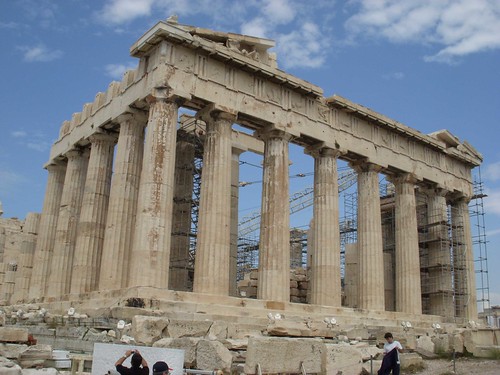It was in the late 4th Century B.C. that Roman and Greek mythology began to intertwine. The Greeks and the Romans were very different people at this point in time. The Romans were war based and worked on expanding their territory. The Greeks, however, were art based. They created beautiful statues that held much importance. By the 2nd Century B.C. the Romans made significant progress in conquering a large portion of Greece. Here their different life styles began to interact and intermix. Before long the gods of theses religions influenced each other and were accepted. This is how we get two different religions with the same gods.
Both of the major and minor gods were in both mythologies. Such as
Erinyes or Furiae, Eris or Discordia, Eros or Cupid, Fates or Morae, Graces or Charities, Helios or Sol, Hours or Horae, Pan or Faunus, and Tyche or Fortuna.
"Much of the Roman mythology was barrowed from the Greeks. But while the stories remain essentially the same, the names have been changed. The Romans also have myths of their own, completely separate from thoses of the Greeks." (Bolton 245)
The Greeks and Romans shared the same stories, but used different names. Such as both religions had the twelve Olympians, but each had different names. The twelve Olympians in Greek mythology are: Zeus, Poseidon, Hades, Hestia, Hera, Ares, Athena, Apollo, Aphrodite, Hermes, Artemis and Hephaestus. The twelve Olympians in Roman mythology are: Jupiter,Neptune, Pluto, Vesta, Juno, Mars, Minerva, Apollo, Venus, Mercury, Diana and Vulcan.

Many of the Roman and Greek gods have the same character, but with different names. One example is the Greek god Zeus. In Roman mythology he is known as Jupiter. However, in both religions he is the lord of the sky, gods, thunder,and Rain. He is also the known as the cloud-gatherer. This shows that both saw him as the same person with the same characteristics, but just used a different name to refer to him.

The gods were like humans, but more magnificent. There superhuman qualities, of courage, skill, and intelligence, were for people to imitate. But these wounderful super beings also fell in love and fought wach other. Even then, they did not suffer pain, or die, as they did not have blood in their bodies, but divine ichor. (Hull 7)
The Greeks and Romans also believed that the same gods created them, but agian just used different names. They thought of their creation as: In the beginning, there was only Chaos and Eros. Gaea, the earth, Erebus, the underworld, and Night emerged from the mixing of these two, and Gaea gave birth to Uranus, the heavens, who then became her mate, and Oceanus, the oceans. Gaea and Uranus together produced the twelve Titans, three Cyclopes, and three hundred-handed giants, or Hecatoncheires, but Uranus feared his children as a threat to his throne, and bade Gaea take them back into her womb. Gaea loved her children, however, and hated Uranus' tyranny. She supplied her youngest child, Chronos, with a sickle, and told him to kill his father with it. He cut off Uranus' genitals, and these fell into the sea and from them were created Aphrodite, the goddess of love, and the Fates, the Giants, and the Meliai nymphs. Chronos succeeded Uranus on the throne and married his sister Rhea. He freed the Titans and shared his kingdom among them, but imprisoned the Cyclopes and the Hecatoncheires in Tartarus, a fiery pit much like Hell. Chronos and Rhea had six children, who would become six of the gods of the Greek pantheon. Chronos, however, was similarly afraid of his children, and decided to swallow him. Rhea plotted to keep the youngest, Zeus, out of Chronos' way, and gave her husband a rock swaddled in cloth to swallow instead. Zeus was raised on the island of Crete and grew into a handsome youth. Eventually he slipped Chronos a drink to vomit up his other five siblings, and they and Prometheus, one of the Titans, fought and defeated Chronos and the Titans for power. Zeus ruled the earth and married his sister Hera; the gods together created humans to entertain and amuse them as they watched from their home on Mount Olympus.
These are the simularities and contrasts of the Roman and Greek gods.
Bolton, Lesley. The Everything Classical Mythology Book. F+W Publications, Inc., Ma, USA, 2002.
Hull, Robert. Religion & the gods. Sea-toSea Publications, Minnesota, Ca, 2007.


















